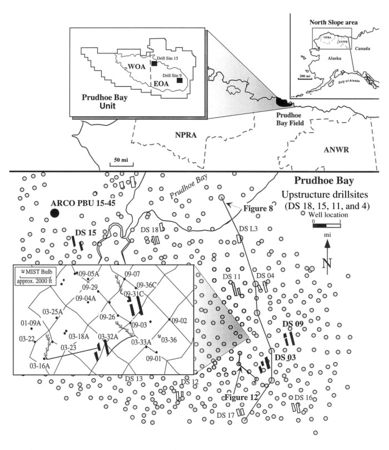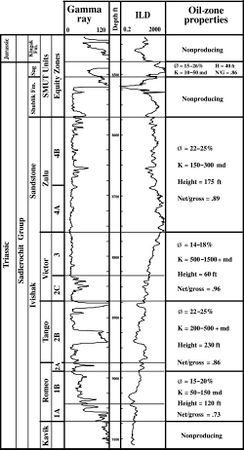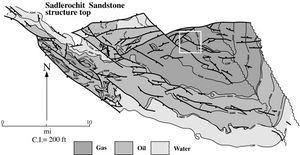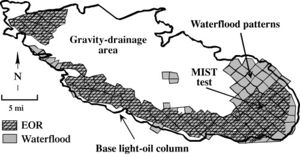Prudhoe Bay field
| Horizontal Wells: Focus on the Reservoir | |
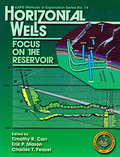
| |
| Series | Methods in Exploration No. 14 |
|---|---|
| Chapter | Results and conclusions of a horizontal-drilling program at South Pass 62 salt-dome field |
| Author | E. P. Mason, M. J. Bastian, R. Detomo, M. N. Hashem, A. J. Hildebrandt |
| Link | Web page |
| Store | AAPG Store |
Prudhoe Bay field lies on the Alaska coastal plain between Naval Petroleum Reserve No. 4 (NPRA) and the Arctic National Wildlife Refuge (ANWR; Figure 1). Present-day production from Permian-Triassic sandstones and conglomerates of the Ivishak Formation (Figure 2) is approximately 550 MSTBD.
Figure 1 Location of Prudhoe Bay field, Alaska. Inset maps highlight the ARCO-operated Eastern Operating Area (EOA). ARCO PBU 15-45 is located in the north-central part of the field. Details of Drill Sites 3 and 9 show where lateral MIST projects are under way.
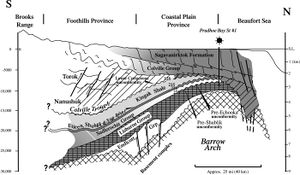
Geologic overview
Several publications relate the exploration process leading to the discovery of Prudhoe Bay field and its geologic characteristics (Morgridge and Smith,[1] Jones and Speers,[2] Jamison et al.[3]). Briefly, Prudhoe Bay field lies along the crest of the Barrow Arch, an east-west-trending, Cretaceous anticline formed by the northward thrusting of the Brooks Range (Figure 3). The southern flank of the Barrow Arch dips gently (2°), whereas the northern flank is much steeper. Sandstones and conglomerates of the Ivishak Formation record the north-to-south advancement of shallow-marine and fluvial depositional systems. At Prudhoe Bay, the Ivishak Formation is unconformably overlain by shallow-marine mudstones, limestones, and fine-grained sandstones of the Shublik and Sag River Formations. The Jurassic Kingak Shale forms the seal.
Prudhoe Bay field is 52 km long by 19 km wide (32 mi by 12 mi). Structurally, the field occurs between 2500 and 2800 m subsea (8200 and 9200 ft), and original oil- and gas-column thicknesses were 142 m (465 ft) and 122 m (400 ft), respectively. Numerous west-to-east- and northwest-to-southeast-trending faults segregate the reservoir into isolated blocks and, in places, enhance fluid migration (Figure 4).
Geologic investigations undertaken since field discovery are almost universal in their acceptance of a fluviodeltaic origin for the Ivishak Formation (Detterman,[4] Morgridge and Smith,[1] Eckelmann et al.,[5] Jones and Speers,[2] Wadman et al.,[6] Jamison et al.,[3] Melvin and Knight,[7] Lawton et al.,[8] McMillen and Colvin,[9] Atkinson et al.,[10] Atkinson et al.,[11] Crowder,[12] Begg et al.,[13] Tye et al.[14]). Fluvial strata have been described as braided-river deposits on a coastal plain (Eckelmann et al.,[5] Jones and Speers,[2] Wadman et al.,[6] Melvin and Knight,[7] Lawton et al.,[8] Atkinson et al.[11]) or on a large alluvial fan (McGowen and Bloch,[15] McGowen et al.[16]). Petrophysically defined layers (SMUT Units; Figure 2) constitute a gross reservoir-layering scheme for this interval, which is approximately 180 m (600 ft) thick (Wadman et al.,[6] Melvin and Knight[7]).
Four reservoir-depletion mechanisms (gravity drainage/gas-cap expansion, waterflooding, miscible-gas flooding, and gas cycling) operate simultaneously at Prudhoe Bay (Figure 5; Szabo and Meyers[17]). Each process is managed to work in concert with the existing fluid distribution (expanding gas cap, injected water, and oil), regional geology (2° southward structural dip; intersecting east-west and northwest-southeast fault trends), and field-scale geology. Interbedded conglomerates, sandstones, and mudstones create a spatially variable rock volume containing permeabilities ranging from a few millidarcys to tens of darcys. Tailoring horizontal wells and their completions to suit specific engineering and geologic conditions significantly increases primary and tertiary recovery from fine-grained sandstones and conglomerates in Prudhoe Bay field.
References
- ↑ 1.0 1.1 Morgridge, D. L., and W. B. Smith Jr., 1972, Geology and discovery of Prudhoe Bay Field, eastern Arctic Slope, Alaska, in R. E. King, ed., Stratigraphic oil and gas field: AAPG Memoir 16, p. 489-501.
- ↑ 2.0 2.1 2.2 Jones, H. P., and R. G. Speers, 1976, Permo-Triassic reservoirs of Prudhoe Bay field, North Sloop Alaska, in Jules Braunstein, ed., North American oil and gas fields, AAPG Memoir 24, p. 23-50.
- ↑ 3.0 3.1 Jamison, H. C., L. D. Brockett, and R. A. McIntosh, 1980, Prudhoe Bay—A ten year perspective, in M. T. Halbouty, ed., Giant oil and gas fields of the decade: AAPG Memoir 30, p. 289-310.
- ↑ Detterman, R. L., 1970, Sedimentary history of the Sadlerochit and Shublik Formations in northeastern Alaska, in W. L. Adkison and M. M. Brosge, eds., Proceedings of the geological seminar on the North Slope of Alaska: AAPG Pacific Section, p. o1-o13.
- ↑ 5.0 5.1 Eckelmann, W. R., R. J. Dewitt, and W. L. Fisher, 1975, Prediction of fluvial-deltaic reservoir geometry, Prudhoe Bay Field, Alaska: Proceedings of the 9th World Petroleum Field, Congress: John Wiley and Sons, International, v. 2, p. 223-227.
- ↑ 6.0 6.1 6.2 Wadman, D. H., D. E. Lamptecht, and I. Mrosovsky, 1979, Joint geologic/engineering analysis of the Sadlerochit Reservoir, Prudhoe Bay Field: Journal of Petroleum Technology, v. 31, p. 933-940.
- ↑ 7.0 7.1 7.2 Melvin, J., and A. S. Knight, 1984, Lithofacies, diagenesis and porosity of the Ivishak Formation, Prudhoe Bay Area, Alaska, in D. A. McDonald and R. C. Surdam, eds., Clastic diagenesis: AAPG Memoir 37, p. 347-365.
- ↑ 8.0 8.1 Lawton, T. F., G. W. Geehan, and B. J. Voorhees, 1987, Lithofacies and depositional environments of the Ivishak Formation, Prudhoe Bay Field, in I. Tailleur and P. Weimer, eds., Alaskan North Slope Geology: Society for Sedimentary Geology (SEPM) Pacific Section, v. 50, p. 61-76.
- ↑ McMillen, K. J., and M. D. Colvin, 1987, Facies correlation and basin analysis of the Ivishak Formation, Arctic National Wildlike Refuge, Alaska, in I. Tailleur and P. Weimer, eds., Alaskan North Slope Geology: Society for Sedimentary Geology (SEPM) Pacific Section, v. 50, p. 381-390.
- ↑ Atkinson, C. D., P. N. Trumbly, and M. C. Kremer, 1988, Sedimentology and depositional environments of the Ivishak Sandstone, Prudhoe Bay field, North Slope, Alaska, in A. J. Lomando and P. M. Harris, eds., Giand Oil and Gas Fields: Society for Sedimentary Geology (SEPM) Core Workshop No. 12, p. 561-613.
- ↑ 11.0 11.1 Atkinson, C. D., J. H. McGowen, S. Bloch, L. L. Lundell, and P. N. Trumbly, 1990, Braidplain and deltaic reservoir, Prudhoe Bay, Alaska, in J. H. Barwis, J. G. McPherson, and R. J. Studlick, eds., Sandstone Petroleum Reservoirs: New York, Springer-Verlag, p. 7-29.
- ↑ Crowder, R. K., 1990, Permian and Triassic sedimentation in the northeastern Brooks Range, Alaska: Deposition of the Sadlerochit Group: AAPG Bulletin, v. 74, no. 9, p. 1351-1370.
- ↑ Begg, S. H., E. R. Gustason, and M. W. Deason, 1992, Characterization of a fluvial-dominated delta: Zone 1 of the Prudhoe Bay Field, Paper No. 24698: Society of Petroleum Engineers 67th Annual Technical Conference, Richardson, Texas, p. 351-364.
- ↑ Tye, R. S., J. P. Bhattacharya, J. A. Lorsong, S. T. Sindelar, D. G. Knock, D. D. Puls, and R. A. Levinson, 1999, Geology and stratigraphy of fluvio-deltaic deposits in the Ivishak Formation: Applications for development of Prudhoe Bay Field, Alaska: AAPG Bulletin, v. 84, no. 10, p. 1205-1228.
- ↑ McGowan, J. H., and S. Bloch, 1985, Depositional facies, diagenesis, and reservoir quality of the Ivishak Sandstone (Sadlerochit Group), Prudhoe Bay Field: AAPG Bulletin, v. 69, p. 286.
- ↑ McGowan, J. H., S. Bloch, and D. Hite, 1987, Depositional facies, diagenesis, and reservoir quality of Ivishak Sandstone (Sadlerochit Group), Prudhoe Bay Field (abs.), in I. Tailleur and P. Weimer, eds., Alaskan North Slope Geology: Society for Sedimentary Geology (SEPM) Pacific Section, p. 84.
- ↑ Szabo, D. J., and K. O Meyers, 1993, Prudhoe Bay: Development history and future potential, Paper No. 26053: Society of Petroleum Engineers Western Regional Meeting, Anchorage, Alaska, p. 1-9.
